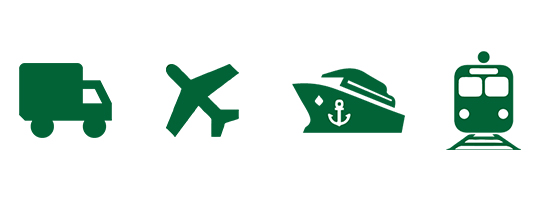4 Easy Ways to Fall Out of HazMat Shipping Compliance
Organizations can make mistakes when it comes to shipping hazardous materials – whether employees are mischaracterizing hazardous articles and substances as non-regulated, regulatory differences between various modes of transport are misunderstood, or employers are failing to ensure the qualification and competency of those involved in shipping.
The following are four common shipping errors that you must avoid and tips that will help you to avoid safety issues, civil penalties, and legal liabilities related to the offering of hazardous materials for transport.
1. Not understanding the regulatory difference between modes of transportation – air vs. highway vs. water vs. rail.
Consider this scenario: a research lab ships non-infectious patient specimens on dry ice routinely with a ground courier, but now offers a shipment with an express air service.
Although dry ice isn't regulated by highway, it is when offered by air. The offeror must meet applicable DOT and IATA requirements.
Employees should never make assumptions. You need to confirm the mode of transit with your carrier so that you can ensure compliance with the proper regulations (see below).

Domestic air using non-IATA operator: 49 CFR Parts 100-185 including specific provisions of Part 175
Domestic air using an IATA operator: IATA Dangerous Goods Regulations
International Air: ICAO Technical Instructions or IATA Dangerous Goods Regulations (if operator policy)
Domestic water: 49 CFR Parts 100-185 including specific provisions of Part 176
International Water: International Maritime Dangerous Goods (IMDG) Regulations
Rail: 49 CFR Parts 100-185 including specific provisions of Part 174
2. Mistakenly assuming that common articles and substances are non-hazardous.
Common items that are potentially hazardous are often offered for transport by employees not traditionally thought of as “hazmat employees.” These shipments easily fly under the radar of the environmental, health, and safety department, and if so, can often be handled by employees that have not been properly trained.
Lithium batteries, for example, are regulated by the DOT as a hazardous material for both ground and air. They are also regulated by ICAO/IATA as Dangerous Goods. The requirements are complex and highly variable depending upon the size of the battery or cell, whether it is shipped alone or with equipment, and whether it is being shipped by air, ground, or water. Some carriers may even require special permission before offering certain lithium batteries for transport.
To see a full list of commonly overlooked hazardous materials, check out our guide 10 Ways to Limit HazMat Shipping Liability.
3. Being unaware of the issues surrounding returns.
Often warehouse, materials management, and receiving personnel get involved in activities that are regulated without realizing it.
Imagine that a package arrives to an organization, and the recipient of the package realizes - after accepting the package from Shipping and Receiving - that it is not what she ordered. The recipient brings the item back to the mail room to ship it back. A Shipping and Receiving employee who does not normally ship hazardous material does not have the training to identify that the laptop to be shipped is actually hazardous material. The employee does not know how to properly prepare or declare the shipment for transport back to the supplier.
Often, employers do not consider scenarios like this one. Rather, they focus compliance concerns on the activities of traditional hazmat shipping personnel.
4. Not determining the “competency” of hazardous materials employees.
For a new “hazmat employee,” training is often the first step to becoming a qualified and competent shipper. Training should occur, of course, but its delivery should not be the only step. Employers are under an obligation to determine competency before authorizing employees to perform hazmat functions, not merely meet the training requirements.
Due to the complexity of hazmat regulations, it often takes considerable time working with a more experienced employee to become proficient in the understanding and use of the regulations, use of applicable software, and hands-on preparation of shipments.
Imagine an employee with no previous experience in hazardous materials being sent to an offsite training class where over 1,300 pages of federal regulations are covered in a one or two-day class. After receiving their training certificate, this employee is made responsible for preparing all hazardous materials shipments without any other internal resources. This is a recipe for future problems.




